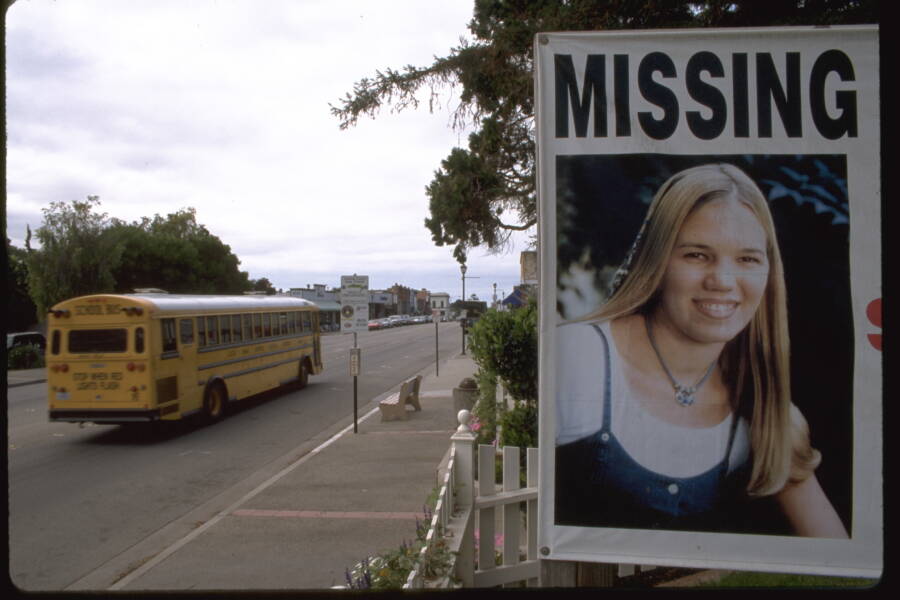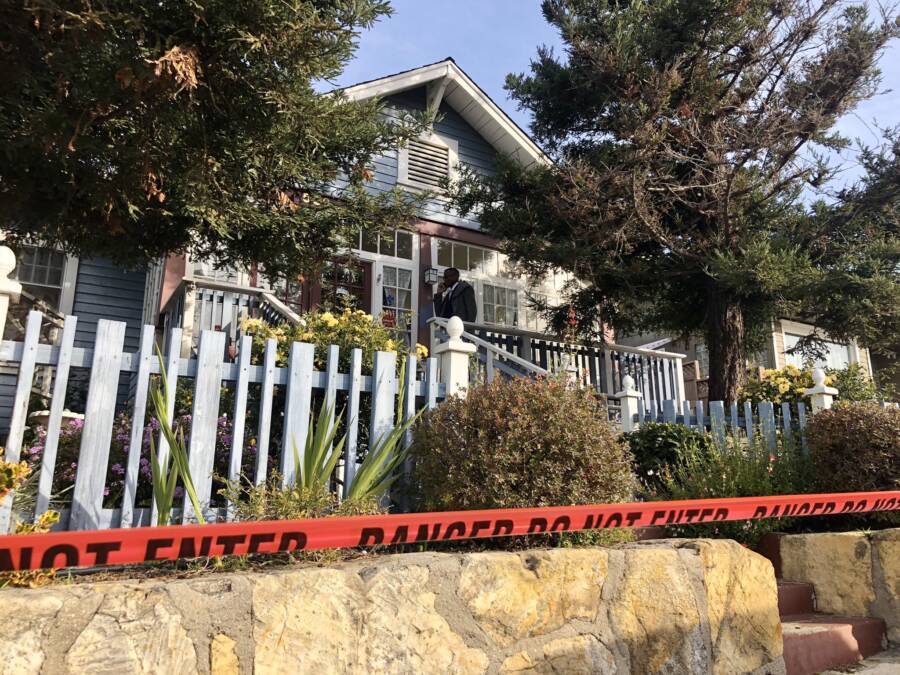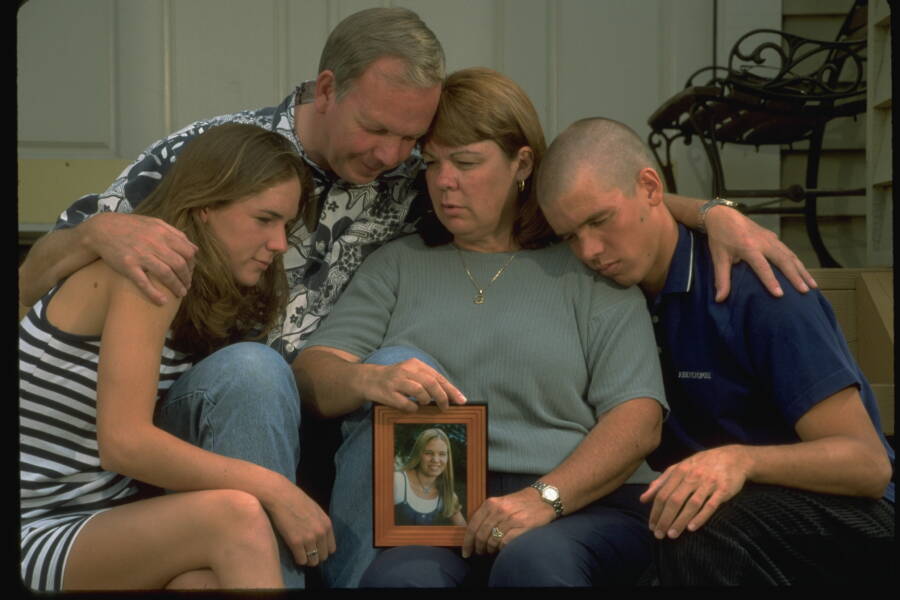On May 25, 1996, Kristin Smart was murdered by her classmate Paul Flores at California Polytechnic State University. He walked free for nearly three decades — until a podcast helped solve the case.

Axel Koester/Sygma via Getty ImagesA missing person poster featuring a photograph of Kristin Smart, who vanished in 1996.
Kristin Smart disappeared on May 25, 1996, while walking back to her dorm at California Polytechnic State University in San Luis Obispo, California after an off-campus party. No one saw the 19-year-old again — and six years later, in 2002, Smart was declared legally dead in absentia.
For decades, it seemed like no one would ever know, for certain, what happened to Kristin Smart. The police had a “person of interest” in Paul Flores, Smart’s classmate who walked her home the night she vanished — and the last person to see her alive. But Flores maintained his innocence, and police were unable to gather enough hard evidence against him.
Then, in 2019, a budding freelance journalist named Chris Lambert created the podcast Your Own Backyard, which covered Smart’s disappearance and reignited interest in the case, helping to bring new information to light. These developments galvanized further investigation into Smart’s murder, which produced enough evidence to officially name Paul Flores as her killer.
Here’s everything you need to know about the case.
The Disappearance Of Kristin Smart

Axel Koester/Sygma via Getty ImagesKristin Smart at her high school graduation.
Kristin Denise Smart was born on February 20, 1977, in Augsburg, Bavaria, West Germany, to Stan and Denise Smart, who were both teaching children of American military service members who were overseas. The Smarts later moved to Stockton, California, where their children attended school.
In 1995, Kristin Smart graduated from high school in Stockton and enrolled at California Polytechnic State University in San Luis Obispo, California.
Then, on May 25, 1996, Smart — now a 19-year-old freshman — attended an off-campus party. She left around 2 a.m., but she didn’t leave alone. She was accompanied by three other Cal Poly students, including Paul Flores.
Unbeknownst to Smart, Flores had earned a negative reputation among women at Cal Poly. According to a 2006 Los Angeles Times report, he had been nicknamed “Chester the Molester” for his behavior at parties.
According to Flores, after he and Smart split off from the other students who had left the party, he and Smart walked toward his dorm in Santa Lucia Hall. He claimed that Smart then headed to her room in the nearby Muir Hall by herself. Kristin Smart was never seen again after that night.
Two days later, Smart’s neighbor in her dorm reached out to campus police and Smart’s parents, as Smart had seemingly vanished into thin air. It was only because of this student’s insistence that campus police opened an investigation, as they had initially assumed that Smart had voluntarily disappeared for a brief period and would be back on campus soon.

Axel Koester/Sygma via Getty ImagesA family photograph of Kristin Smart.
An incident report from campus police at the time also seemed to judge Smart harshly for drinking alcohol at the off-campus party shortly before her disappearance, according to her family. The report read:
“Smart does not have any close friends at Cal Poly. Smart appeared to be under the influence of alcohol on Friday night. Smart was talking with and socializing with several different males at the party. Smart lives her life in her own way, not conforming to typical teenage behavior. These observations are in no way implying that her behavior caused her disappearance, but they provide a picture of her conduct on the night of her disappearance.”
Despite the slow start of the investigation, missing-person posters and billboards began to pop up in public places and along roads in the area, offering rewards for information that could help find Kristin Smart.
Soon, two investigators from the district attorney’s office were called in to help the campus police with the case, and they quickly zeroed in on Flores. When they interviewed him, they noticed numerous inconsistencies in his story, most notably his changing story about how he got a black eye.
Flores was eventually identified as a “person of interest,” but he denied any involvement in Smart’s disappearance. And despite his suspicious behavior, police struggled to definitively link him to the crime.
How Paul Flores’ Silence And A Botched Investigation Let Him Go Free For Years

TwitterThe rental property of Paul Flores’ mother Susan, where a tenant found an earring that may have belonged to Smart.
In June 1996, the San Luis Obispo County Sheriff’s Office took over the Kristin Smart case. The Cal Poly campus was then combed over by police and volunteers alike. When cadaver dogs were brought in to search the dorms at Cal Poly, three of them reacted to what had been Flores’ room.
Then, in the fall of 1996, a woman named Mary Lassiter was renting a house that belonged to Paul Flores’ mother Susan in Arroyo Grande, California. During her stay, she found a single woman’s earring in the driveway that appeared to match a necklace worn by Smart on one of the billboards she had seen of the missing teenager. Lassiter turned the earring over to the police — but they lost it before they could mark it as evidence.
Susan Flores’ house naturally became the focus of widespread speculation, though police only searched it later on in the investigation. Though the backyard was searched several times, no further evidence was found there.
As reported by Yahoo! News, police eventually did find biological evidence of Smart’s body at a different Flores property — but that was more than two decades after the first investigation. With police unable to build a strong enough case early on, Flores was not initially arrested or charged.
Then, in 1997, the Smart family filed a $40 million wrongful death lawsuit against Paul Flores, still the main person of interest in the case.

Don Kelsen/Los Angeles Times via Getty ImagesPaul Flores (right) with his lawyer in 2006.
During a deposition later that year for the civil suit, Flores invoked the Fifth Amendment 27 times on the advice of his lawyer.
The only answers he provided were his name, his birth date, and his Social Security number. He would not, on the other hand, answer questions about whether he was a Cal Poly student in May 1996, the name of his father, or even if he cooked hamburgers at his job at Garland’s Hamburgers.
The tactic seemingly worked, with police soon admitting that without any new information from Flores, the investigation had stalled.
“We need Paul Flores to tell us what happened to Kristin Smart,” said San Luis Obispo’s then-Sheriff Ed Williams. “The fact of the matter is we have very qualified detectives who have conducted well over a hundred interviews, and everything leads to Mr. Flores. There are no other suspects. So absent something from Mr. Flores, I don’t see us completing this case.”
In 2002, six years after her disappearance, Kristin Smart was declared legally dead in absentia and Flores was still a free man, according to The New York Times. For several years, the case would remain at a standstill, and the Smarts seemed to be no closer to getting justice for their daughter.

Axel Koester/Sygma via Getty ImagesKristin Smart’s family gathers around a photo of her.
But things started to look up in 2011 when San Luis Obispo got a new sheriff.
When Sheriff Ian Parkinson took the job, he made a promise to the Smart family that solving Kristin Smart’s case would be a top priority.
And he kept his promise. Parkinson’s department would carry out 23 search warrants and 96 interviews. They also collected 258 pieces of evidence. Through it all, they still had only one suspect: Paul Flores.
Still, the case against Flores was missing evidence. But in 2019, the investigation got some much-needed aid from an unlikely source: a podcast focused on Smart’s disappearance by freelance journalist Chris Lambert.
Lambert, who was only eight years old when Kristin Smart disappeared in 1996 and had no initial connection with her family, helped spark a wave of new information about the case that would help lead to Flores’ arrest.
How A Podcast Helped Solve Kristin Smart’s Murder More Than Two Decades After The Fact

TwitterChris Lambert, the podcaster who examined Kristin Smart’s case and helped bring it to national attention once again.
According to Vanity Fair, Chris Lambert lived about half an hour from Cal Poly’s campus, and had no formal training as a journalist or documentarian, yet the Kristin Smart case endlessly fascinated him.
One day, he emailed his girlfriend a link to a Los Angeles Times story about Smart, jokingly saying that he was going to solve the case. He also told a writer friend of his about his interest in Smart’s disappearance, and the friend told him that she remembered the Smart story from years earlier.
That same friend later emailed Lambert with more information: “I can’t believe I didn’t tell you; I went to school with the guy who walked her home that night. I went to high school with him. We all called him Scary Paul.”
This inspired him to create a podcast about the case in 2019, and it quickly became a hit, garnering nearly 75,000 streams on the day that the first episode was posted. As word spread about the podcast, more and more people began reaching out to Lambert with new information about Smart and Flores. Multiple people alleged seeing Flores taking advantage of several inebriated women, and some even accused Flores of sexual assault.
Lambert also began a working relationship with the San Luis Obispo County Sheriff’s Office, sharing sources and letting the police interview them before he would. When Paul Flores was finally arrested for Kristin Smart’s murder in April 2021, many people — including the police and Smart’s family — looked to Lambert’s podcast as a driving force behind the investigation. (Paul’s father Ruben was also arrested and charged with being an accessory after the murder, as it was believed he helped his son hide Smart’s body.)

San Luis Obispo Sheriff’s OfficeMugshots of Paul and Ruben Flores.
“Chris was able to fill in a part of the puzzle along with the dedicated members of the sheriff’s office who worked this case over the years and the district attorney’s office who successfully prosecuted this case,” Sheriff Parkinson said of the podcast’s impact on the investigation.
Lambert was in attendance throughout the murder trial in 2022, which ended with Paul Flores, who was 45 years old at the time, being found guilty of the first-degree murder of Kristin Smart. He was later sentenced to 25 years to life in prison for the crime. (Paul’s father, Ruben Flores, was acquitted of the accessory charge by a separate jury.)
“It started to hit me in waves, and I just started crying,” Lambert said. “I was thinking about where this started, was thinking about my relationship with the Smart family.”
Lambert had met Denise Smart shortly after he started the podcast and expressed his desire to share her daughter’s story — the real story, not one that, like early reports, judged Smart for partying the night she vanished.
“It was that victim shaming,” Denise Smart said. “People don’t want to connect with that, because it’s like, Oh, it’s that girl with the shorts going to a party getting drunk? Oh, well, that’s what happens when you do that. And my kids would never do that. Sharing the real story is so important. My friends and I call Chris an angel in disguise.”
After learning about the case of Kristin Smart, see how DNA helped to solve a 40-year-old cold case murder of a California kindergartner. Then, dive into these 11 cold cases that were solved thanks to “Unsolved Mysteries.”





